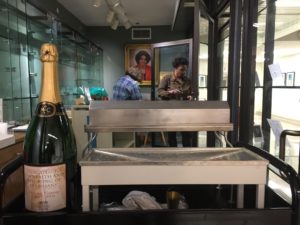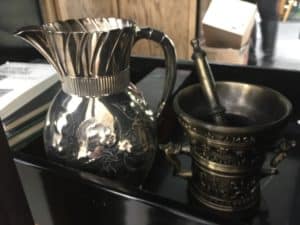New Exhibit Celebrates 140th Anniversary of UAMS
| Turning 140 years old means having a lot of history to celebrate.

A large bottle used to ceremonially open the College of Public Health and model dissection tables designed by a faculty member in the College of Medicine (eventually built and used at UAMS) sit on a tray of artifacts being installed by Suzanne Easley and April Hughes of the UAMS Historical Research Center.
That history is the focus of a new exhibit composed by the UAMS Historical Research Center on display across from the College of Medicine administrative offices on the first floor of the Central Building.
Those who researched, curated and installed the display said covering so much history in such a relatively small space is no easy task.
“I think the biggest challenge is deciding what to include in the exhibit,” said Tim Nutt, director of the Historical Research Center. “Naturally, we wanted to touch on all aspects of university history, not just one particular college.
“We don’t have as many materials from some colleges, simply because they have a shorter history. That’s a challenge in and of itself. On the other hand, we have so many materials from other colleges, deciding what to use and what to leave out is a difficult decision.”
Because the exhibit celebrates all parts of the institution and covers its entire history, every historical artifact in the center’s collection could be considered for inclusion. To narrow the options, the exhibit curators envisioned telling the story of UAMS’ growth – and challenges overcome. So they began their planning at the beginning.
“I wanted to talk about the founders, because if it weren’t for them, we wouldn’t be here,” said administrative analyst April Hughes, who installed the exhibit. “They needed to be highlighted with whatever artifacts or anything we might have pertaining to them.”

A silver pitcher that once belonged to an original founder of UAMS and an antique mortar and pestle from the College of Pharmacy await display.
So the exhibit includes photographs of the eight physicians who pooled their money to found what was originally the Medical Department of the Arkansas Industrial University, as well as artifacts that belonged to them: an antique microscope used by Roscoe Green Jennings, M.D.; a golden-headed cane (a traditional gift for instructors in medical education) that belonged to Augustus L. Breysacher, M.D.; and a silver pitcher belonging to Edwin Bentley, M.D.
“The pitcher was actually once damaged in a fire and buried in the rubble. But it was identified by an inscription, donated to the university and restored,” said Nutt. “We are always grateful for donated artifacts – from the colleges, alumni, former faculty or anyone – because they help us tell the story of our history.”
That story wouldn’t be complete without a sense of place, however.
“I felt we also needed to know about the different places UAMS has been located throughout its history,” said Hughes.
So the exhibit includes photographs of past campuses, from its origins at the Sperindio Hotel on W. 2nd Street downtown (since torn down) to the present day, including the Old State House and the building that is now the William H. Bowen School of Law, part of the University of Arkansas at Little Rock. Alongside these pictures are relics of campuses, including bricks from the original student dormitory recovered after its implosion to build the new hospital.
Central to the exhibit is a photograph of the 1934 groundbreaking at the location in MacArthur Park, along with a shovel used in the groundbreaking ceremony for the Education II building in 1974 – with ribbons still attached.
“It’s an honor for the Historical Research Center to actually own that artifact,” said Hughes.
Nearby, a portrait celebrates former Gov. Sid McMath, who campaigned in the 1950s for funding to move the institution to its present location, which was then at the western outskirts of town. The move combined school and hospital and established “the new UAMS Medical Center,” as illustrated in a contemporary announcement included in the exhibit.
Below the portrait is a desk that always sits in the exhibit space to display literature about the Historical Research Center. This time, though, the desk is actually part of the exhibit as a piece of original furniture from the opening of the current campus.
Each college has its own space in the exhibit, along with the Graduate School, celebrating certain milestones, such as the first female College of Medicine graduate or a newspaper article announcing the first nursing graduates in 1957. Artifacts include an oversized bottle that was filled with Arkansas sparking water to christen the College of Public Health and an antique mortar and pestle once used in the College of Pharmacy.
“We wanted to tell the totality of the history of UAMS, not just focus only on the people or the buildings or the accomplishments,” said Nutt, who added that each topic could be an entire exhibit on its own.

Annie A. Schoppach, M.D., who graduated in 1901, is featured in the exhibit as the first female graduate of the College of Medicine.
It’s in the name of totality that the exhibit includes a nod to historical extracurricular sports organizations and even off-campus locations that became part of UAMS history, such as the storied watering hole Peck’s, which used to be a popular student hangout across Markham.
“You can never tell the whole story because we don’t have enough room,” said Nutt. “So we tried to tell stories that people will find interesting, that will draw them in and hopefully draw them to the Historical Research Center, on the fifth floor of the library, where they can find out much more about the university.”

